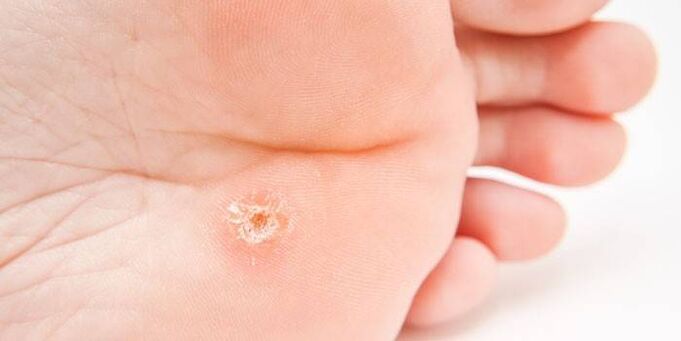From time immemorial, the ugly compounds in the body have troubled humanity. Warts on the feet are a skin disease caused by a virus. People with skin defects were afraid of infection and tried to eliminate it as soon as possible by seeing a neoplasm on the heel or other part of the body. What people don't apply to plantar warts is if they disappear forever. So far, dermatologists are looking for the most effective and painless way to fight the disease.
What is a wart
Human papillomavirus causes benign or oncological DNA mutations in skin cells. The body is covered with papillomas, warts, papules. More than a hundred types of HPV have been studied. A wart is a skin growth that indicates the presence of the first or third type of papilloma virus in the body. Neoplasms are not potentially carcinogenic, but are highly contagious due to the viability of the pathogen in the external environment.
What does a wart look like?
Plantar neoplasm has a round shape with clear edges a few millimeters or centimeters in size. Black dots of clogged capillaries appear in the center. They look like old dry calluses that grow on the skin of the feet. The pain caused by plantar growth is not directly under pressure, but during compression. The absence of papillary lines on the foot is characteristic.

Causes of plantar warts
HPV infection is more common during unprotected sex. The virus penetrates through micro-cracks in the mucous membranes of the genitals. Some have HPV in transit, while others are less fortunate - the virus stays in the body for a long time without warning. Dermatologists do not rule out that the appearance of papillomas on the surface of the feet is promoted by immune disorders and infectious diseases.
Walking barefoot in public places: in baths, swimming pools, body salons, shared bathrooms, on the beach, barefoot shoes are the most common causes of plantar warts. The virus is alive outside the home and can be found on towels, tiles, clothes, furniture, guest shoes, and more. on "waiting for the victim. "The infection is caused by tight, stretched areas of skin on the plantar surfaces and palms where the papilloma virus enters with minor lesions.
Warts on children's feet
Children are anxious and often injured. Parents may be unaware of the presence of HPV in their child's body as a result of cuts and abrasions. With the weakening of immunity, the virus is activated, papilloma appears on the foot. In children, painful methods of combating warts on the legs are often contraindicated, poorly tolerated. Often, a child's body fights this disease of the skin of the feet on its own.
Types of warts on the legs
Warts are a collection of skin lesions caused by papilloma. Depending on the external manifestations and effects on human health, the following types of warts are classified:
- vulgar (ordinary) - round keratinized blisters;
- flat - a rash in the form of rising spots on the skin;
- filiform (acrocords) - extends with "torn" edges formed in the folds of the body;
- genital sneezing - reminiscent of a cock comb;
- Aging (keratomas) - occurring in the elderly, not associated with HPV.
Wart formations are localized throughout the body, in the internal organs, in the oral cavity. Warts on the feet, called plantar warts, are a common type. One type includes well-formed depression of the skin, which is characterized by rapid growth. The appearance of subungual growths slightly elevates the nail plate.

Treatment of plantar warts
It is dangerous to neglect the treatment of plantar warts. Neoplasms in the legs are constantly injured. They are removed to stop the appearance of new growths and the entry of infections. There is no complete cure for HPV. Treatment is reduced until the disease becomes a "sleep mode". Available medications, surgery, immunomodulatory removal of plantar warts, using alternative medicine.
The disadvantage of treatment of plantar growths is where they are located: a large layer of epidermis, which makes it difficult to deliver the active ingredients to the depths of the formation in the foot. In preparation for therapy, the top layer of the collection is wetted and exfoliated. Traditionally, treatment for warts on the feet begins with the use of salicylic acid. The wart on the foot is steamed and disinfected daily in a bath for three months, then the softened top layer is cleaned with pumice stone, salicylic acid is applied and a patch is applied.
Pharmacy chains advise how to get rid of warts on the feet with the help of drugs containing celandine, phenol, trichloroacetic acid. The drugs cause tissue necrosis, relieving the patient of the deficiency, but leaving a mark on the healing of a deep wart wound. Each disease is different to varying degrees, so before choosing a method to remove a wart under the foot, you should consult your doctor.
Ointment
According to the method of action, there are necrotic, antiviral, herbal ointments. In the first case, the acid or alkali based on the ointment burns the painful growth and leaves a scar. At home, you can use liquid solutions for the treatment of feet: containing vinegar, nitrogen, oxalic, lactic acids. The surface of the neoplasm is carefully treated to prevent burns.
Antiviral ointment for warts on the feet is applied to the growth itself and around it to reduce the growth of infection. They are used with special ointments. Herbal substances only affect the formation of the skin. The applicator is known for its effectiveness in the treatment of foot balm with colhamine ointment.
Modern removal methods
The advent of modern methods of removing warts has replaced the traumatic scalpel. Like a surgeon's knife, an electrocoagulator burns the neoplasm of the foot with an electric current. After the procedure, which is removed by laser or radio waves, a depression remains in the foot. The treatment takes several weeks. The effects of liquid nitrogen are considered a very painful treatment and require several treatments. In 2014, British dermatologists published the latest material on antigen injection therapy. It will help patients who are resistant to existing treatments.

Folk remedies
Folk remedies for warts on the legs are performed before bedtime, with pre-steamed legs and for a long time. During treatment, protect your hands with latex gloves to prevent further spread of infection, and disinfect all devices and utensils used to prevent infection of your loved ones. Here is a list of effective folk remedies to get rid of warts:
- Garlic is known for its antibiotic properties. In a neoplasm at the bottom, the upper hardened layer is cut, and a thin clove of garlic is applied.
- You can make "anti-beard paste". Knead finely chopped garlic, vinegar, wheat flour, spread on the surface of the neoplasm and cover with plaster. After a few days, the dough is removed along with the collection.
- Put an onion soaked in vinegar on the foot or you can rub the growth with vinegar, then add fresh onions.
- You can fill the formation with the juice of herbs: celandine, Kalanchoe, calendula, milk thistle, dandelion, golden mustache or a slice of apple, add mountain ash, figs, potatoes, horseradish, cabbage. The procedure is performed daily, for several weeks to months, until the accumulation disappears.
- You can make wood ash diluted in water to a creamy state.
- The growth is sprinkled with powdered chalk and wrapped in a bandage. Do not soak the compress.
- Salicylic birch and willow bark have proven to be effective in treatment. The bark is applied to the foot, pre-softened with boiling water.
- Hot foot baths with sea salt, soda, laundry soap, tea tree oil or spruce broth help in the treatment of foot diseases. Treatments can be mixed or alternative.
- Wormwood juice applications are used. 3 tablespoons dried wormwood herb brewed in a glass of boiling water, insist at least 2 hours.














































































